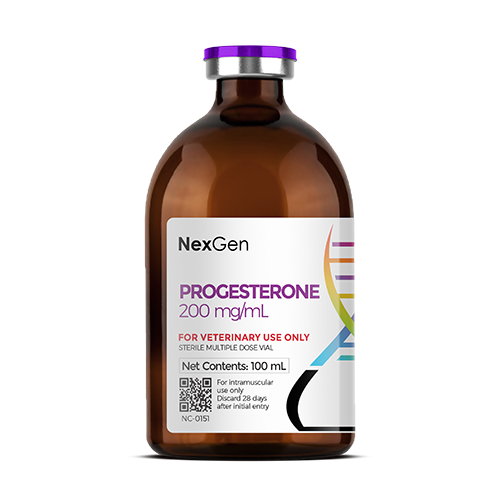
Progesterone 200 mg/mL, Injection, 100mL
Login for pricing
- Brand
- Mixlab
- SKU:
- NC-0151
- Product Type:
- Injectable
- Size:
- 100ml
- Administration:
- Intramuscular
Progesterone For Equines
It is quite common for horse owners and managers to require mares to enter into estrus and ovulate within a specific time period. This may be because they intend to use frozen semen to impregnate a mare, or because a stallion may be scheduled for delivery at a specific time to impregnate a mare.
Since mares have been known to be unpredictable in the timing of their ovulation, this can lead to frustration and uncertainty on the part of the owner and attending veterinarian.1 As a result, horse breeders are continuously developing new and better protocols for achieving the objective of timing control.
During the breeding season, mares will cycle normally and exhibit sexual receptivity to the stallion while producing healthy follicles that ovulate. The breeding season begins in the middle of Spring and continues through the Fall. If the mare does not become pregnant, she will undergo a succession of cycles throughout the breeding season, with each cycle lasting around 22 days.
The mare’s estrous cycle consists of two parts, these being estrus and diestrus. Estrus is considered the “heat” portion of the cycle; this is also the time when follicular maturation and ovulation occur.2 During diestrus, the mare is not receptive to the stallion. The duration of estrus is approximately three to seven days, with ovulation occurring between 24 to 48 hours prior its end. At the end of estrus, the mare enters diestrus. The follicle that developed during ovulation then develops into the corpus luteum (CL).3 If the mare has not become pregnant, this will be absorbed into the mare’s body.
When Timing is Essential
Given the practical need for manipulating the timing of ovulation in the mare, several drugs have proven useful in bringing about ovulation and facilitating the coordination of schedules that work with breeding farms (as well as the stallion and the mare).3 A number of effective compounds can help horse owners and managers induce ovulation, but few are as widely applicable as progesterone. This is an endogenous steroid and progestogen sex hormone involved in the menstrual cycle, pregnancy, and embryogenesis.
Progestins are routinely used to manage ovulation, but studies have shown that by themselves, they do not reliably control follicular development, and it is possible to have ovulations occurring during treatment.4
Progesterone Warnings and Side Effects
Horse breeders and managers should be warned that progestins do carry some side effects which are potentially life-threatening in carnivores (mostly domestic dogs and cats). Across many species, increased appetite and weight gain are common with the use of progestins.2 They have also been associated with lethargy, hair loss, and hair discoloration.3 In horses, the most frequently reported side effect relative to the administration of progesterone in oil has been injection site reaction, which can be addressed with the use of low dose NSAIDs.
Progesterone for Breeding Management in Horses
Progesterone has long been used to synchronize estrus cycles for better breeding efficiency, to prevent mares from coming into heat, to organize or regulate heat cycles during the mare's seasonal transition and to help maintain pregnancy. Progesterone has also been used to manage “moody mares.”5
Since there is a marked increase in estrogen which accompanies follicular development, there is often an impact on on the mare’s behavior.7 These behaviors can be disagreeable in working horses; therefore, progesterone has been widely used to manage “moody mares” as well as for breeding management.
Synthetic progestins often produce effects which can negatively impact the reproductive process, such as impeding the progression of sperm and eggs to the site of fertilization and interfering with embryo implantation. “Progestins also have a negative feedback effect on areas of the hypothalamus and pituitary involved in reproduction by suppressing the hypothalamic-pituitary-gonadal axis, progestins prevent the hormonal cascade that stimulates estrus and ovulation in females and spermatogenesis and libido in males. Progestin treatment of females can block ovulation by suppressing luteinizing hormone (LH) release from the pituitary, but levels of follicle-stimulating hormone (FSH) may remain high,” which can stimulate follicle growth and estradiol production.4
Where to buy Progesterone
Progesterone is available in the U.S. through pharmaceutical manufacturers and through veterinary custom compounding companies.
FOR RX ONLY: A valid prescription from a licensed veterinarian is required for dispensing this medication.
1equine-reproduction.com.
2Hemberg E, Lundeheim N, Einarsson S. Successful timing of ovulation using deslorelin (Ovuplant) is labour-saving in mares aimed for single AI with frozen semen. Reprod Domest Anim. 2006 Dec;41(6):535-7. doi: 10.1111/j.1439-0531.2006.00709.x. PMID: 17107513.
3Merck Veterinary Manual.
4Beijerink, et. al. Basal and GnRH-induced secretion of FSH and LH in anestrous versus ovariectomized bitches. Theriogenology 67 (2007) 1039–1045.
5equimed.com.
7Volkmann D. Rational Use of Progestagen Therapy During Pregnancy. Western Veterinary Conference 2010 2010. 2010.




















